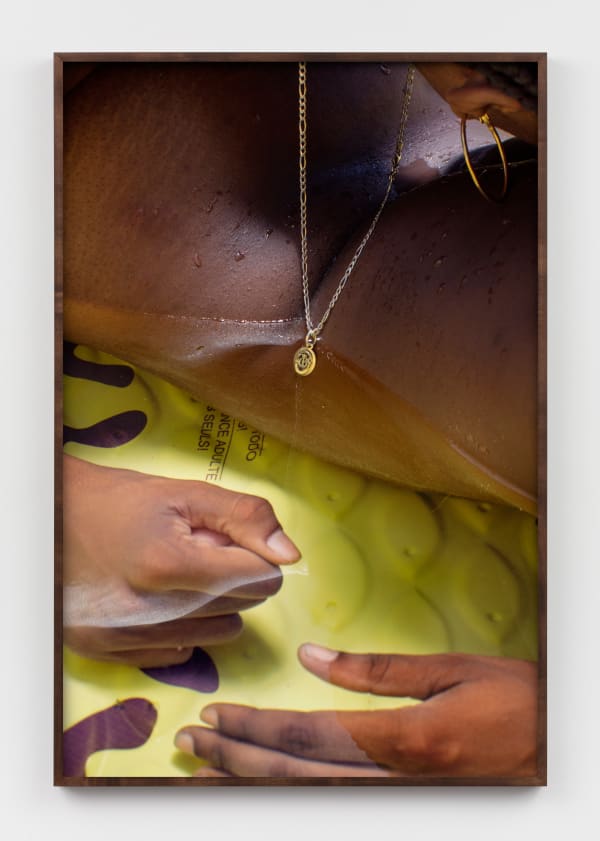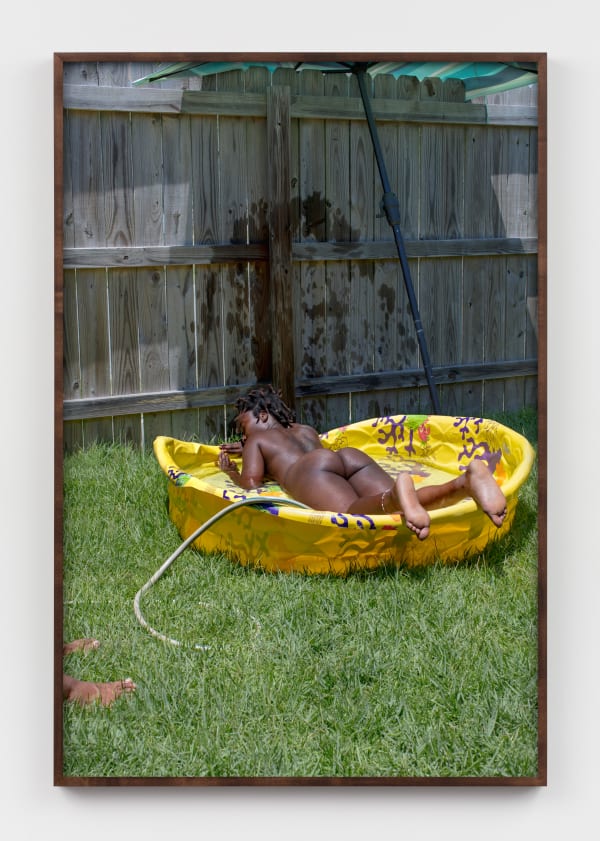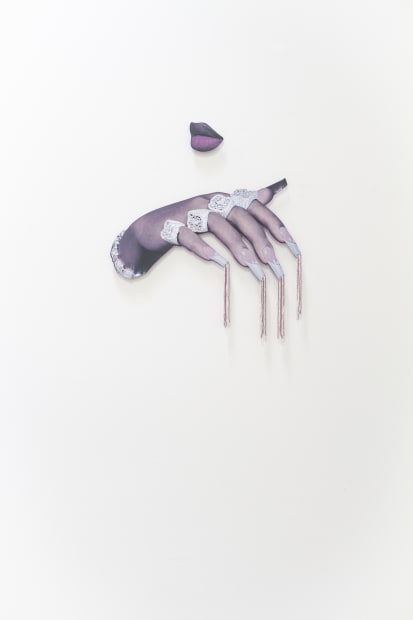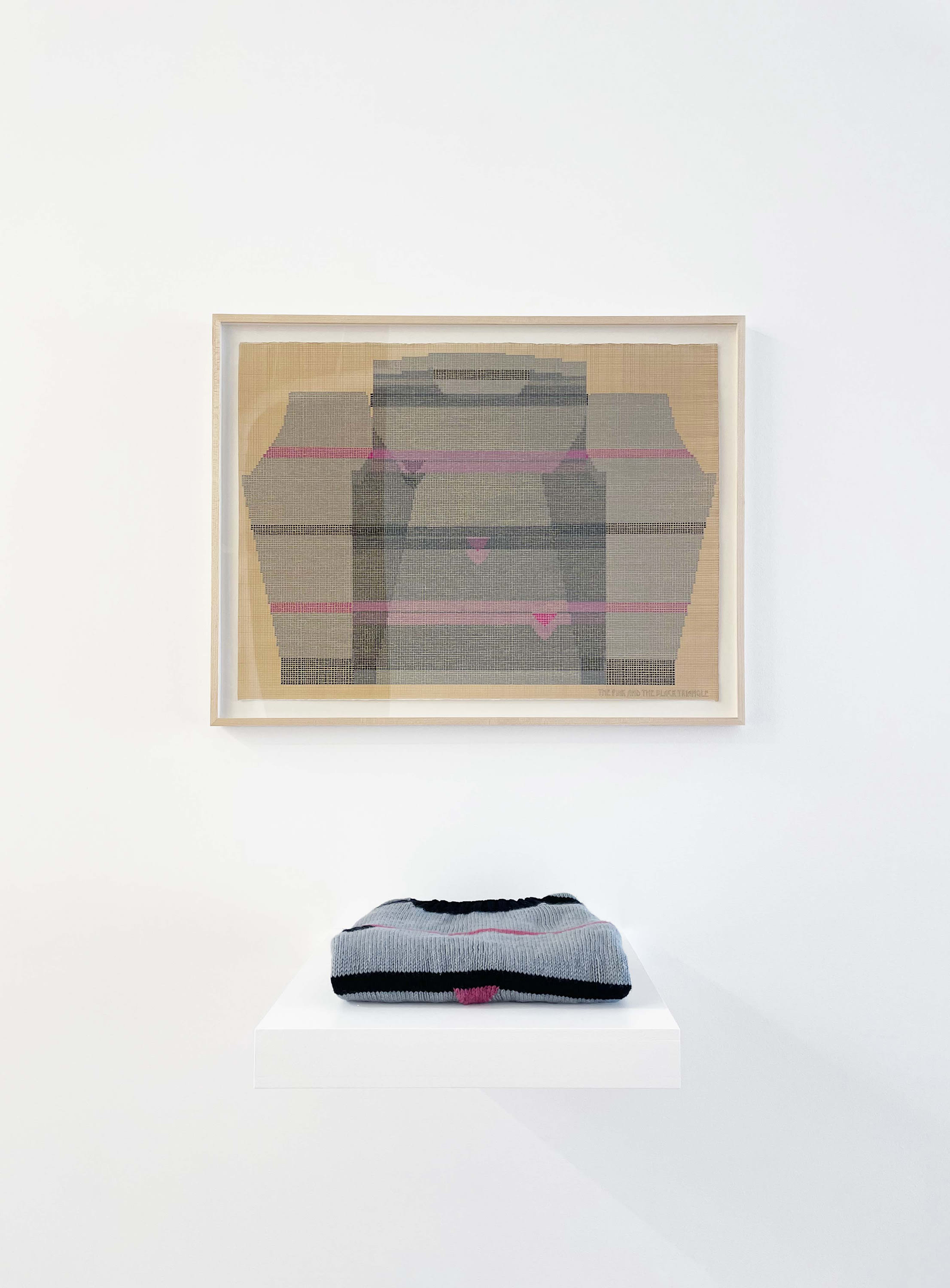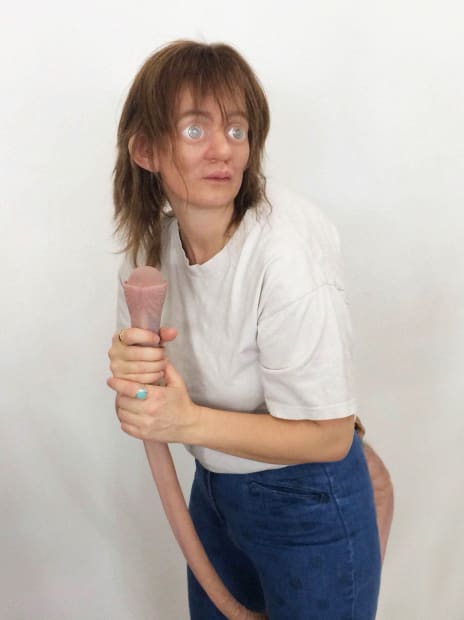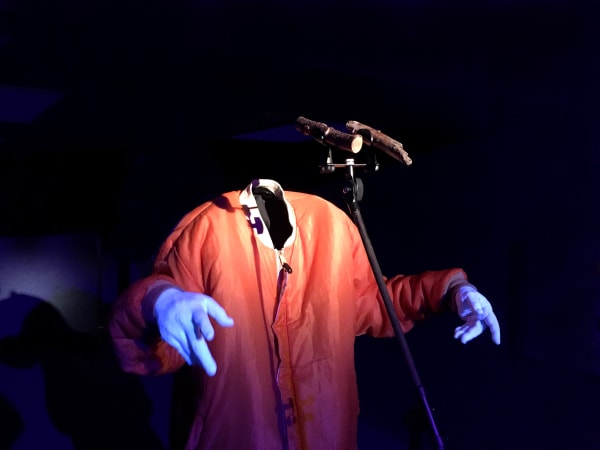-

-
Shulamit Nazarian is pleased to present Intersecting Selves, a group exhibition featuring Elliott Jerome Brown Jr., Maria A. Guzmán Capron, Amir H. Fallah, Wendell Gladstone, Julie Henson, Ellen Lesperance, Ebony G. Patterson, and Tori Wrånes.
Each of the artists in Intersecting Selves considers the body as a barrier between the mind and the outside world. Recognizing our competing desire for privacy and awareness, and the often thin boundary that intersects our public and private selves, these artists dictate what gets revealed, to whom, and on what terms. From the quietly personal to the urgently political, each artist engages with depictions of the body while withholding crucial information and context. In doing so, they maintain a position of power and restraint over the viewer and, simultaneously, beckon for a closer engagement.
The exhibiting artists of Intersecting Selves—which takes its name from one of Gladstone’s paintings in the exhibition—evoke various strategies of representation. These artists utilize self-portraiture, employ avatars, and appropriate archival imagery to trouble the distance between the viewer and their subject. Bodies become draped in fabrics, lost in costume, and abstracted through the various mediums exhibited, including photography, collage, painting, and fibers.
-
 Wendell GladstoneIntersecting Selves, 2021Acrylic on canvas80 x 66 inches
Wendell GladstoneIntersecting Selves, 2021Acrylic on canvas80 x 66 inches -
 Wendell GladstoneCocoon, 2021Acrylic on canvas82 x 66 inches
Wendell GladstoneCocoon, 2021Acrylic on canvas82 x 66 inches -
Elliott Jerome Brown Jr. positions his portrait practice within intimate spaces, often taking place in domestic settings such as the yard, front porch, or living room. Brown’s portraiture favors a calculated distance between his subject and the viewer. Abstracted notions of the body figure more prominently than his subjects’ faces, which are often obscured or excluded entirely. The tilting diagonals of the surrounding architecture further signal Brown’s avoidance of an informative, frontal view. The obfuscation of his subjects challenges the traditional hierarchy held within photography, which for so long has privileged the viewer’s ability to gaze versus the privacy of the subject. For Brown, the use of shadow, cropping, focus, and composition are all employed as tools that slow down the act of looking. The result is a more profound articulation of the interior or physiological space of his subject, as opposed to a portrait of their physical likeness.
-
-
Elliott Jerome Brown Jr. (b. 1993, Baldwin, NY; Lives and works in Brooklyn, NY) has been featured in exhibitions domestically and internationally. Brown Jr. was a participant in the Skowhegan School of Painting and Sculpture in 2017 and in the New York Times Portfolio Review 2016. He received his BFA in Photography from the Tisch School of the Arts, New York University. His work has recently been exhibited in Any distance between us, RISD Museum of Art, Providence, RI; New Photography: Create, Collect, Compile, New Orleans Museum of Art; A Language for Intimacy, Abrons Arts Centre and Boston Center for the Arts; On Refusal: Representation and Resistance in Contemporary American Art, The MAC, Belfast, Ireland; and has been the subject of a solo exhibition at Nicelle Beauchene Gallery, New York, NY.
-
-
-
Made specifically for this exhibition, Amir H. Fallah has created two new paintings from his ongoing series of veil portraits that interrogate systems of representation in Western art history and the contemporary presentation of oneself. By veiling his subjects, his paintings question modes of portraiture while simultaneously using personal history as an entry point to discuss race, the body, and cultural memories. In Fallah’s works, the absence of the sitter’s likeness is substituted with a broader representation of their personhood—one that spans time and cultures and is articulated through a network of symbols and imagery. Fallah’s paintings question the historical role of portraiture and the cultural systems used to identify one person from another.
-
Amir H. Fallah (b. 1979 Tehran, Iran; Lives and works in Los Angeles) has exhibited extensively across the United States and abroad. Selected solo exhibitions include the Museum of Contemporary Art in Tucson; South Dakota Art Museum, Brookings, SD; Schneider Museum of Art, Ashland, OR; San Diego Art Institute; ICA San Jose; and the Nerman Museum of Contemporary Art, Overland, KS. His work is in the permanent collection of the Jorge M. Pérez Collection, Miami; McEvoy Foundation For The Arts, San Francisco; SMART Museum of Art at the University of Chicago; Davis Museum, Massachusetts; The Microsoft Collection, Washington; Plattsburgh State Art Museum, NY; Cerritos College Public Art Collection, CA; and Salsali Private Museum, Dubai, UAE; Museum Of Art and History, Lancaster, CA; Van Every/Smith Galleries, Davidson College, NC. Fallah received his BFA in Fine Art & Painting at the Maryland Institute College of Art and his MFA in Painting at the University of California, Los Angeles. He is represented by Shulamit Nazarian.
-
 Julie HensonI'm Doing Me, 2021Pigment print on aluminum, beaded fringe16 x 18.5 in
Julie HensonI'm Doing Me, 2021Pigment print on aluminum, beaded fringe16 x 18.5 in
40.6 x 47 cm -
 Julie HensonBetween Reality and Theater, 2021Pigment print on aluminum, beaded fringe12.5 x 24.5 in
Julie HensonBetween Reality and Theater, 2021Pigment print on aluminum, beaded fringe12.5 x 24.5 in
31.8 x 62.2 cm -
 Julie HensonSell the Fantasy, 2021Pigment print on aluminum, charms30 x 30 in
Julie HensonSell the Fantasy, 2021Pigment print on aluminum, charms30 x 30 in
76.2 x 76.2 cm -
Through paintings on paper, rendered in gouache, Ellen Lesperance utilizes universal knitting vernacular to recreate historic garments worn by women activists, warriors, and cultural figures. For the past decade, she archived protest knitwear worn by the feminists of the Greenham Common Women's Peace Camp, a women's encampment that demonstrated against U.S. nuclear weapons storage in Berkshire, England (1981 to 2000). Lesperance is inspired by the protestors' creative direct-action tactics, including the use of sweaters with knit-in language and protest symbols. Her practice involves a close study of archival photographs, film, and video footage of these women-led protests. She then maps out and replicates their sweaters into two-dimensional abstracted patterns, which is an impulse to represent women in ways that evade the patriarchal legacy of figurative painting. In 2020, Lesperance published a book of this archive titled Velvet Fist. These abstracted forms and paintings become an homage and proxy for the brave activists.
-
 Ellen LesperanceThe Pink and the Black Triangle, 2020Gouache and graphite on tea stained paper, wool sweater hand-knit by the artistDrawing 22 x 29.5 inches
Ellen LesperanceThe Pink and the Black Triangle, 2020Gouache and graphite on tea stained paper, wool sweater hand-knit by the artistDrawing 22 x 29.5 inches
Sweater Dimensions Variable -
Ellen Lesperance (b.1971, Minneapolis, MN; Lives and works in Portland, OR) has exhibited widely in the United States and internationally. Solo exhibitions of her work have been presented at Derek Eller Gallery, NY; Baltimore Art Museum; Portland Art Museum; Galerie Anne de Villepoix, Paris, FR; and Seattle Art Museum. She has participated in significant group exhibitions internationally, most recently at the Tang Teaching Museum, Saratoga Springs, NY; Institute of Contemporary Art, Boston; Frye Museum, Seattle; Museum of Art São Paulo, Brazil; Nottingham Contemporary and De La Warr Pavilion, United Kingdom); Honolulu Biennial; Brooklyn Museum; Tate St. Ives, UK; and The New Museum, NY.
-
 Ebony G. Patterson...for souls...for soles...between the cuts, beneath the leaves, below the soil.., 2021Work on paper107 x 97.5 x 14 inches
Ebony G. Patterson...for souls...for soles...between the cuts, beneath the leaves, below the soil.., 2021Work on paper107 x 97.5 x 14 inches -
Ebony G. Patterson (b. 1981 in Kingston, Jamaica; Lives and works in Kingston and Chicago, IL) received her BFA from Edna Manley College, Kingston, Jamaica in 2004 and MFA from Sam Fox School of Design & Visual Arts, Washington University, St. Louis in 2006. Patterson’s solo exhibitions and projects include the Baltimore Museum of Art; The Studio Museum in Harlem; Atlanta Center for Contemporary Art; and SCAD Museum of Art Savannah, GA. Her work was included in Open Spaces Kansas City, MO; the 32nd Bienal de São Paulo; the 12th Havana Biennial; Prospect.3: Notes for Now, New Orleans, and the Jamaica Biennial. Patterson’s works are included in a number of public collections, including the Whitney Museum of American Art; Virginia Museum of Fine Arts; Brooklyn Museum; The Studio Museum in Harlem; and the National Gallery of Jamaica. Her first major survey exhibition …while the dew is still on the roses… opened at Pérez Art Museum Miami in 2018; then toured to Speed Art Museum in Louisville, KY; the Nasher Museum Durham, NC; the Contemporary Art Museum, St. Louis; Kunsthal Aarhus, Denmark, and the ICA San Jose. It will be included in the upcoming Athens and Liverpool Biennials in 2021.
-
 Tori WrånesThe Singer, 2021PhotographImage: 4.6 x 3.5 inches
Tori WrånesThe Singer, 2021PhotographImage: 4.6 x 3.5 inches
Framed: 23.8 x 18.7 inchesEdition of 10 plus 2 artist's proofs -
Tori Wrånes (b. 1978 in Kristiansand, Norway; Lives and works Oslo, Norway) Her recent solo shows include Handmade Acoustics at Ujazdowski Castle for Contemporary Art in Warszawa; Hot Pocket at Museum of Contemporary Art, Oslo; Ældgammel Baby / Ancient Baby, Kunsthal Charlottenborg Denmark; Flute Warriors, with Red Comunitaria Trans, Bogotà, Colombia; and Drastic Pants, Carl Freedman Gallery London. Select performances include Stone and Singer commissioned by the 19Th Biennale of Sydney; Yes Nix, commissioned by Performa 13, NY; Colombo Art Biennale, Sri Lanka; Dhaka Art Seminars, Bangladesh; CCA Lagos, Nigeria; The Eccentrics, Sculpture Center, New York, NY. Recently commissioned work includes Naam Yai, for Thailand Biennale in Krabi. She is represented by Shulamit Nazarian.
Intersecting Selves: Elliott Jerome Brown Jr., Maria A. Guzmán Capron, Amir H. Fallah, Wendell Gladstone, Julie Henson, Ellen Lesperance, Ebony G. Patterson, and Tori Wrånes
Past viewing_room




